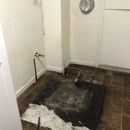Suggestions for Removing/Capping Pipes Please
I live in Seattle and qualified for an income sensitive program where the City’s Department of Housing funded the decommissioning of my oil-fired burner (Logano Buderis) and underground oil tank and installed a Mitsubishi Heat Pump. My oil-fired burner was not very old and was not giving me problems. It worked great. I switched over because the City is offering incentives to move people from oil to electric and because a new oil tax has been imposed greatly increasing the cost of oil. I’ve attached pictures of the area where the contractor removed my oil-fired burner. As you can see, there are some tubes and pipes that are not capped (I believe these were the pipes that fed oil to the burner from where they are located) and a few holes that go under my house and down to the open crawlspace below. There are also some electrical wires and a couple of boxes/electric fixtures?? that are uncovered. When the rehab specialist for the City came by to do a weatherization assessment, he covered some of the holes with tape and also, at my request, tested the boxes/wires and some were hot. I asked him what could be done about the way this area was left because I have a young grandson and don’t want him getting shocked or hurt and the rehab specialist said that removal/closure of the tubes/pipes was not part of the project and I can apply for a low-interest rehab/weatherization loan to have these things done. I understand if they don’t want to remove the concrete, although it is a trip hazard (the rehab specialist tripped on it himself) but the other things are dangerous. I’m unemployed so unable to qualify for a loan but want to make this area safe and if possible, get it cleaned up and usable. Any advice would be great. Thank you!
GBA Detail Library
A collection of one thousand construction details organized by climate and house part










Replies
I expect you needed an inspection for this work. Has the inspection been completed? Because I would point out the fact that the contractor didn't actually finish their job if they left these things exposed. A reasonable inspector would fail the inspection, which would prevent the contractor from getting paid, and then they'd come and do their job.
If the inspections are completed, you need to escalate this through the part of the city that runs this program. Leaving exposed wires that are hot is simply unworkmanlike and unacceptable by any standard.
Leaving live electrical wiring exposed is a no-no, even temporarily. That should have been removed, even if the pipes (conduits, in the case of electrical “pipe”) were not removed. I would actually argue that removing at least the wiring would be part of the SAFE removal of the old boiler and should have been included in the project.
The small copper pipe in the front is probably the old fuel line. The larger black iron pipes are likely the old hot water lines. The water lines can probably just be cut flush with the floor or wall, but the fuel line may need to be sealed depending on local codes.
It is probably worth contacting the contractor and explaining what is going on, see what they say. If they don’t want to do the work, call your local building department to see if they would require that work to have been done to pass the job and “green tag” it. If the building department people say the old lines should have been removed, they may be able to call your contractor and get this done for you.
Bill
As bill stated, you should be able to just cut and cover up the water lines. If the oil tank is gone and the line is dead ended, same. Looks like a 24 volt transformer on the wall for the thermostat. You should be able to remove it, cap off the wires and put a wall plate on the box. I don't see any other power lines so they must have removed those. Is that wall switch below the transformer for the boiler? If it is live, just turn off the breaker.